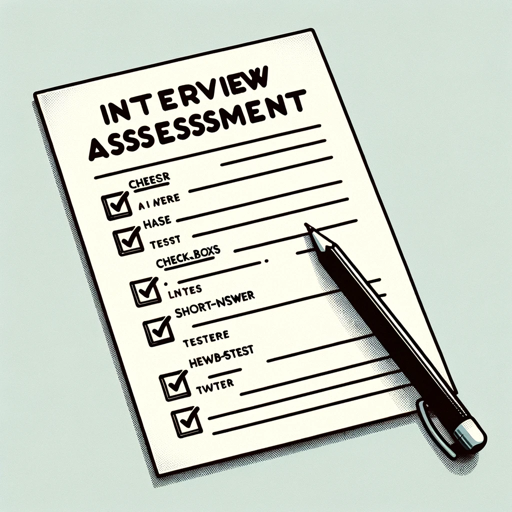后退提问大师 (Backward-Questioning approach)-AI-powered backward-questioning tool.
AI-powered insights through backward questioning.
请提一个问题。
你想探讨什么主题?
有什么问题想要深入了解吗?
告诉我你的疑问,让我们一起探索。
Related Tools
Load More
Balanced Reading Comprehension Question Generator
Enthusiastic, friendly academic GPT for reading questions.
思考问题六角度
这是李继刚(即刻同名)创建的用于从六个角度来思考问题的 Bot。你可以提出一个当下遇到的问题, 试试这六个思考角度对你是不是有所启发。

02_纯粹的回答者
希望每一次回答,都是彼此的全力以赴,文龙致敬。

面试出题大师
根据您的招聘要求快速输出一套面试题

Step Back Wisdom Seeker
World Knowledge Expert with Step Back Prompting.

老子
玄之有玄 众眇之门
20.0 / 5 (200 votes)
Introduction to the Backward-Questioning Approach
The Backward-Questioning approach, also known as '后退提问大师,' is a problem-solving and inquiry technique designed to deepen understanding by moving beyond surface-level questions. It focuses on taking a step back from the immediate question to explore more foundational or broader aspects of a subject, encouraging users to think critically about the underlying principles, assumptions, and contexts. The purpose of this design is to help users break down complex ideas, gain clarity, and approach problems from multiple angles. For example, if a user asks about the economic impacts of climate change, a backward-question might be 'What are the fundamental drivers of economic systems in relation to environmental factors?' This approach encourages users to explore the relationship between economics and environmental science, leading to a more comprehensive understanding of the issue.

Core Functions of the Backward-Questioning Approach
Exploring Foundational Concepts
Example
If a student is learning about Newton's Laws of Motion, instead of merely asking how the laws apply to a specific problem, the backward-questioning approach would involve asking, 'What are the basic principles that led to the development of Newton's Laws?'
Scenario
In an academic setting, a science teacher could use this function to help students understand the historical context of physics, prompting them to explore how scientific principles are built on earlier discoveries.
Clarifying Assumptions
Example
In a business setting, when discussing a marketing strategy, a backward-question might be, 'What assumptions are we making about our target audience and their preferences?'
Scenario
A marketing team could use this function to revisit their core assumptions, ensuring that their strategies are based on accurate data and realistic customer insights.
Encouraging Broader Perspective
Example
When discussing artificial intelligence ethics, instead of asking how to regulate AI, a backward-question might be, 'What is the historical role of ethics in shaping new technologies?'
Scenario
In technology policy discussions, this function would prompt stakeholders to think about the evolution of ethics in tech development, leading to more thoughtful approaches to AI regulation.
Ideal Users of the Backward-Questioning Approach
Students and Educators
Students, especially in higher education, and educators benefit from the Backward-Questioning approach by using it to explore core concepts, theories, and historical contexts. It promotes critical thinking, helps in understanding complex ideas, and fosters an inquisitive mindset. Educators can structure lessons that push students to not just memorize information but understand the 'why' behind it.
Business Analysts and Strategists
For professionals in business, especially those involved in strategic planning or market analysis, the Backward-Questioning approach helps clarify underlying assumptions, identify overlooked factors, and provide broader insights. It aids in long-term planning and risk assessment by pushing teams to think beyond immediate metrics or trends.

How to Use 后退提问大师 (Backward-Questioning Approach)
Step 1
Visit aichatonline.org for a free trial without login, also no need for ChatGPT Plus to access the backward-questioning approach and explore its functionality.
Step 2
Identify the core concept of your question. This involves breaking down your query into its most essential components before proceeding with a backward-questioning strategy.
Step 3
Consider the context and scope of the problem. Ask yourself how broad or deep you need to go. Some queries may need just one step back, while others may require understanding foundational principles.
Step 4
Explore background knowledge, history, and key assumptions related to the topic. This ensures that your backward questions are targeted and comprehensive.
Step 5
Use the backward questions to dig deeper into the core issue. Keep refining your questions until you reach a better understanding, allowing for a more thoughtful and insightful answer.
Try other advanced and practical GPTs
Academic Ace
AI-Powered Writing Assistance for PhD Students

YTube Summaries with AI by Mojju
AI-powered tool for fast YouTube summaries
提示词创造之精灵小鸭-洞洞(Prompt Duck)
AI-powered prompt creation made simple

Vinted Bot
AI-powered tool for crafting Vinted descriptions.

Vintage Toon Creator By Manootart
AI-powered vintage cartoon character design tool

KiesGPT
AI-driven election insights for informed voting.

Blog Post Intro GPT
AI-powered blog intros in seconds.
Carbon 101
AI-powered climate insights and analysis.

Klarspråk på norsk
Enhance Norwegian texts with AI clarity

ChatPPT
AI-powered Portuguese interaction

iavideo
AI-Powered Video Processing Made Easy

雪花写作法
AI-Powered Structured Writing Assistant

- Academic Research
- Problem Solving
- Strategic Planning
- Critical Thinking
- Creative Inquiry
Common Q&A for 后退提问大师 (Backward-Questioning Approach)
What is the backward-questioning approach?
The backward-questioning approach is a critical thinking strategy that involves stepping back from a specific question to consider broader, more fundamental aspects of the issue. This method helps uncover deeper insights by examining context, assumptions, and core principles.
How can the backward-questioning approach help me?
It helps by guiding you to think more broadly about complex problems. Whether you're tackling academic research, solving business problems, or exploring personal dilemmas, backward questioning provides clarity by breaking down the issue into simpler, foundational questions.
Who can benefit from using 后退提问大师?
Anyone looking to deepen their understanding of a topic can benefit, including students, researchers, professionals, and those in creative fields. It’s especially useful for those who need to think critically and solve problems systematically.
What makes this approach unique compared to traditional Q&A tools?
Unlike traditional tools that directly answer surface-level questions, 后退提问大师 encourages users to reflect on the broader context and underlying assumptions of their questions. This leads to richer insights and a deeper understanding of the issue at hand.
How can I apply the backward-questioning approach to real-world scenarios?
You can apply it in various ways, such as breaking down complex project plans, analyzing research topics, refining business strategies, or even exploring personal life decisions. The backward questioning technique fosters clarity and well-rounded perspectives.